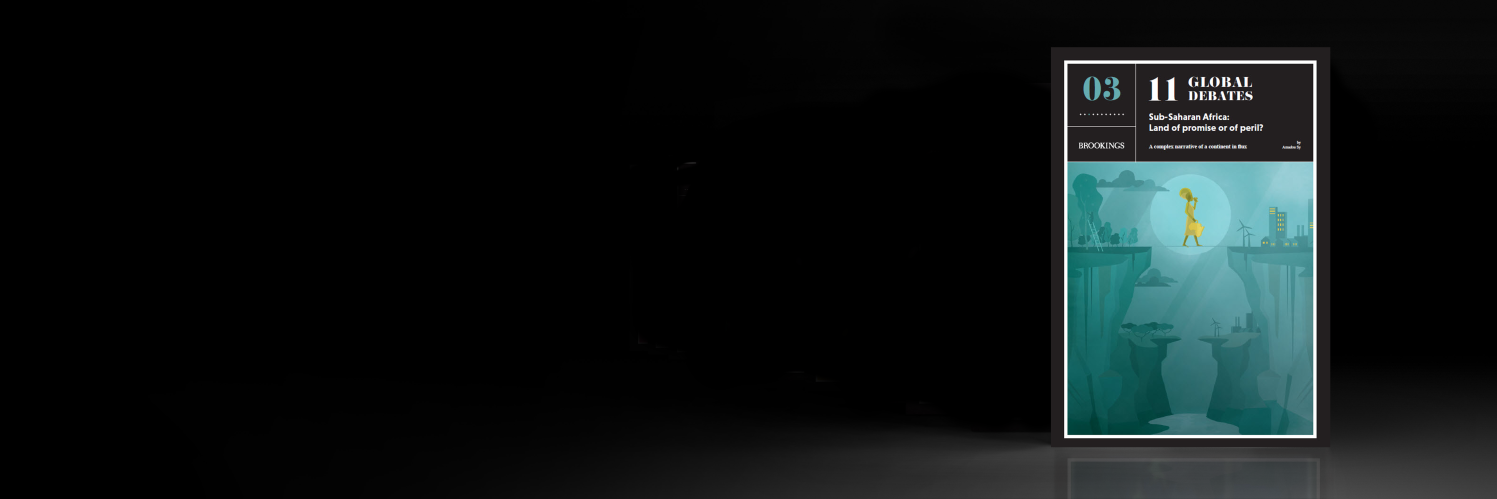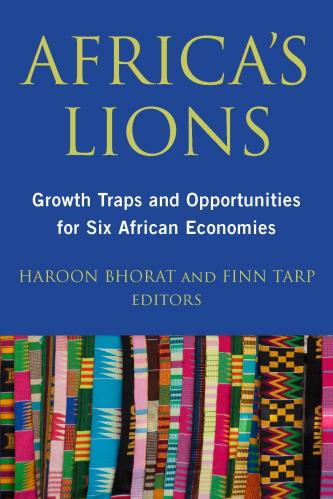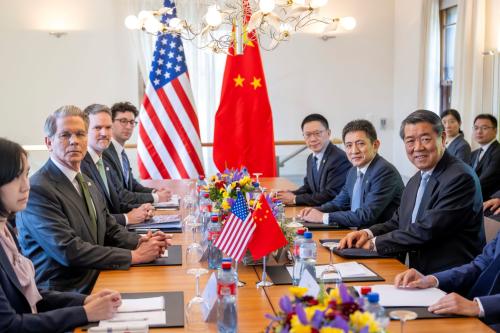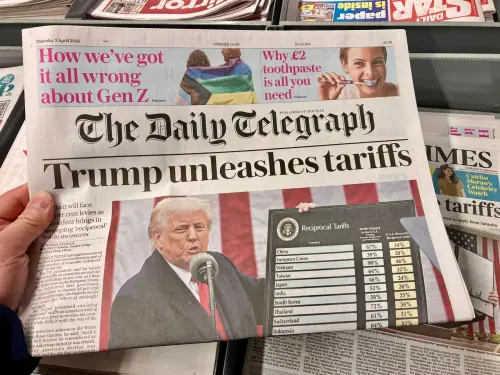This report is part of a series of essays by the Global Economy and Development program—a 10th anniversary edition. The series, available here, delves into the critical issues facing all those concerned about globalization. You can join the conversation on Twitter using #11GlobalDebates. To read the report in French, click here.
1.1 What’s the issue?
After more than a decade of relatively strong economic progress, sub-Saharan Africa’s aggregate GDP growth is slowing as external shocks threaten recent advances. According to the International Monetary Fund’s April 2016 Regional Economic Outlook for sub-Saharan Africa, between 2000 and 2015, the continent grew at an average rate of 5.5 percent.
This was due in part to a commodity slump, with the price of oil falling from $108 to $47 per barrel between June 2014 and January 2015.
3.4% was the region wide growth rate in 2015, the lowest level in about 15 years.
Today, oil prices remain relatively low. Adding to that has been a China slowdown, worries over higher U.S. interest rates, climate effects from El Niño threatening agricultural production, and serious conflict in parts of the continent.
1.2 What’s the debate?
The region’s economic promise is in peril and a rethink of the narrative on Africa is underway. The storyline has swung before—from one of hopelessness (recall The Economist cover in 2000, “Africa the hopeless continent”) to one of exuberance (recall The Economist cover in 2011, “Africa rising”).
The hopeless story, which pops up periodically, is one of a continent beset by stalled growth. For example, deteriorating terms–of–trade after the oil shocks in the 1970s hurt commodity-dependent African countries. In 2015, the region’s terms-of-trade deterioration was estimated at 18.3 percent in aggregate, though for oil-exporters it was 40 percent (Africa Pulse, 2015).
African countries are also plagued by fragile institutions. In the 1970s and 1980s, news was dominated by coups, civil wars, and rising strong men. The twin blows of anemic economic growth and poor institutions set back human development and trapped far too many in poverty.
The story shifted from the mid-1990s onward. This was thanks in part to rebuilt political institutions, foreign assistance tied to macroeconomic and fiscal reforms, debt reduction or forgiveness, work to advance the Millennium Development Goals, and the disappearance of colonial vestiges from the Cold War. Another boost came from national reform and accountability measures as well as successful campaign efforts by in-country civil society activists.
Also fueling the rosier scenario was a concerted effort to tackle the region’s infrastructure gap as well as a pivot by China to support trade and investment rather than simply to use “checkbook” diplomacy. Foreigners and Africans began focusing on the following positive trends: the region’s youth bulge, which constitutes a dividend if young workers can develop skills to compete; growing digital dividends, such as those earned by M-Pesa, a highly successful mobile payment company; the rising middle class and their enormous potential as consumers; and rapid urbanization. In addition to these positive trends, regional integration efforts have improved.
150 million people live in the East African Community.
A continental free trade agreement was even signed recently. Human development improved hand in hand with economic growth, with the child mortality rate falling two and a half times faster between 2000 and 2015 than between 1985 and 2000.
Yet the pendulum is swinging back, as Chinese policymakers have reacted to economic slowdown by reducing reliance on domestic investment and curbing their appetite for imported commodities.
Within the region, threats include cross-border violence in the Sahel, around the Lake Chad basin, in the Gulf of Guinea where piracy is rampant, and in Eastern Congo where violence is still a concern. Although peaceful elections are on the rise, some leaders have learnt quickly how to win elections but not improve institutions. Fragile countries with poor institutions as well as security and humanitarian situations that require U.N. or regional peacekeeping operations continue to dampen prospects. The situation is particularly deplorable in South Sudan and dark clouds still loom above the Democratic Republic of Congo, the Central African Republic, and Burundi.
1.3 What to watch out for?
Missed in the binary of a hopeless versus a rosy narrative are large disparities among countries in terms of political and economic governance.
Commodity exporters like oil-rich Nigeria and Angola and copper-rich Zambia have been particularly hard hit. Conflict-affected countries such as the Central African Republic, Guinea, and Guinea Bissau are yet to recover. Others like Mozambique, Ghana, and South Africa still suffer from self-inflicted wounds. Mozambique’s indebtedness was grossly underestimated as the scale of government-guaranteed debt emerged. Ghana’s post-electoral fiscal position deteriorated and South Africa is experiencing anemic growth because of faulty decision making and energy disruptions. Many countries are vulnerable to higher external refinancing costs as their currencies fall relative to the U.S. dollar. In the first six months of 2016, Nigeria’s naira fell by 29 percent against the U.S. dollar.
1.2 billion people will be living in the region in 2025, according to conservative estimates.
Members of the Economic Community of Central African States have even borrowed from their central bank, a quite risky proposition.
While boom times seem to be over for oil-exporting countries, prospects look hopeful for several other countries, including Kenya, a commodity-importer. Though labeled fragile, Ivory Coast has revived growth from a low base and energized its agricultural production, becoming the world’s largest cashew nut producer (on top of already being the largest cocoa producer). Ethiopia, using a Chinese inspired growth model, has grown fast, though the impact of El Niño may be negative.
Tailored sector-specific opportunities may help some economies pull out of the slump. For example, the retail sector remains attractive in the wealthier suburbs of Lagos and Nairobi where shopping malls are popping up. Cement production in many countries, including Ethiopia, is expanding. Energy generation, especially from renewable sources such as solar, hydro-, and geothermal energy, also hold potential. A transport corridor (the Northern Corridor) linking five East African countries should boost trade, while plans for highways in West Africa will better connect cities there. Digital payments systems are expanding rapidly, particularly in fragile countries.
1.4 What’s next?
A consensus is emerging among African policymakers about what needs to be done, driven in part by global commitments linked to the Sustainable Development Goals, climate plans agreed at the Paris Conference of the Parties, and the Addis commitments for financing development agreed by the international community in 2015.
While sound macroeconomic policies remain essential, economic diversification is more important now than ever, especially for commodity exporters. For instance, according to OPEC, oil exports represent 90 and 95 percent of total exports in Nigeria and Angola, respectively. Diversification must also involve stepped up public investment, including for infrastructure. This has recently been achieved through the issuance of eurobonds, which increased from $200 million in 2006 to $1.6 billion in 2015 (Mbu, 2016). Nevertheless, countries will need to rely more on safer domestic financing sources and improve the quality of public spending.
Another priority is to connect to global and regional value chains in agro-processing and light manufacturing. As part of this, structural transformation and infrastructure improvements are essential. Better stewardship of the region’s primary commodities matters too, since new discoveries are being made and the resulting revenues will need to be managed for current and future generations.
With the region’s population expected to exceed 1.2 billion by 2025, due in part to a youth bulge, finding jobs for youth and women is vital. Governments, together with the private and the non-profit sectors, should work together to adapt education systems so that they equip students to compete for the jobs of the future. All stakeholders should do more to support small businesses and young entrepreneurs. Achieving “pro-poor” growth across the continent may require taking a page from the Asian model of improved agriculture productivity and greater support for light manufacturing.
The potential offered by technology to boost job growth merits attention too. The manufacturing sector is being transformed as automation and robots make some low-skilled jobs obsolete. The services sector—one of Africa’s main engines of growth—is dominated by the informal sector, which is often plagued by low productivity. To really take off, services need support from African policymakers, including incentives for technological upgrades and funding for worker training.
Ultimately, national policymakers with a sense of urgency and the drive to implement concrete strategies will be crucial to realizing the region’s promise. They are forging ahead in some countries, even if the path is not smooth. Getting lagging countries on board is the biggest challenge. Doing so requires a mix of domestic policies and global governance reforms. For now, it may be the domestic actors who hold the most potential to be the main agents of change.
The Brookings Institution is committed to quality, independence, and impact.
We are supported by a diverse array of funders. In line with our values and policies, each Brookings publication represents the sole views of its author(s).






